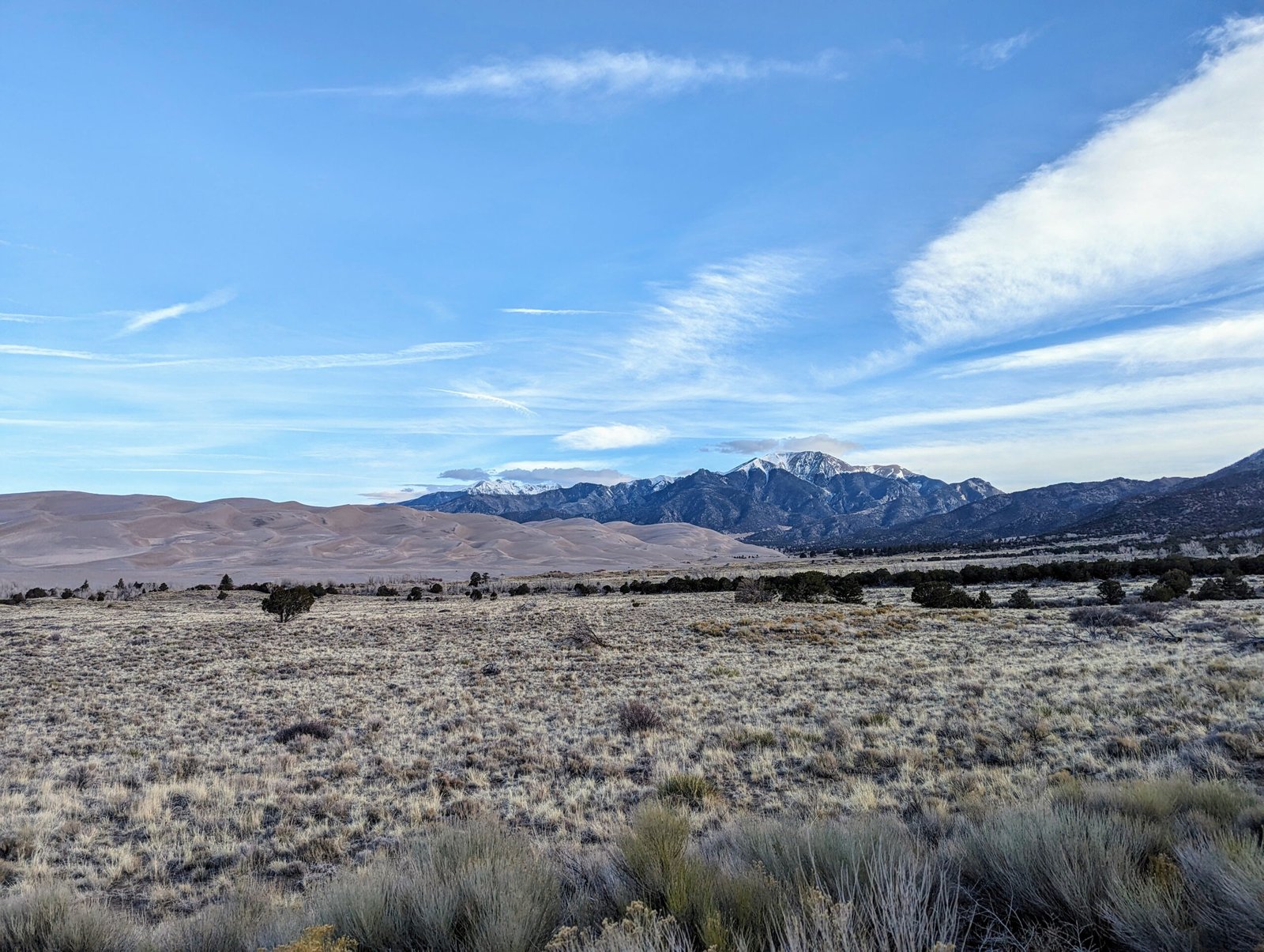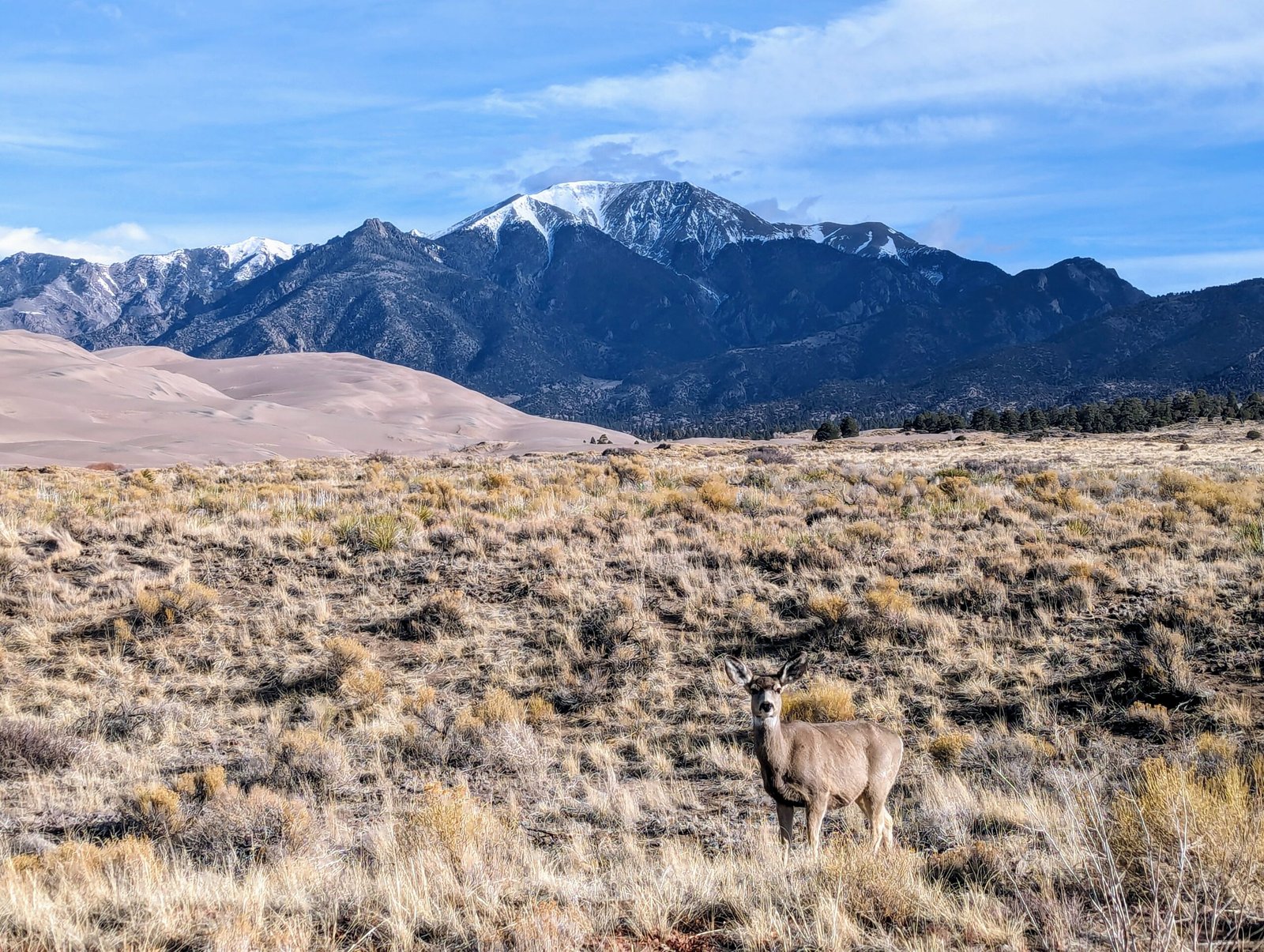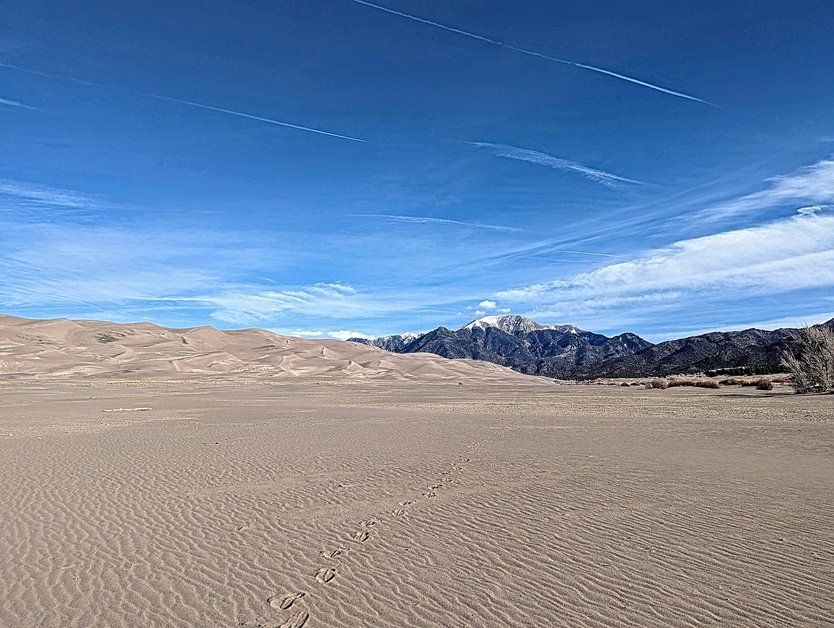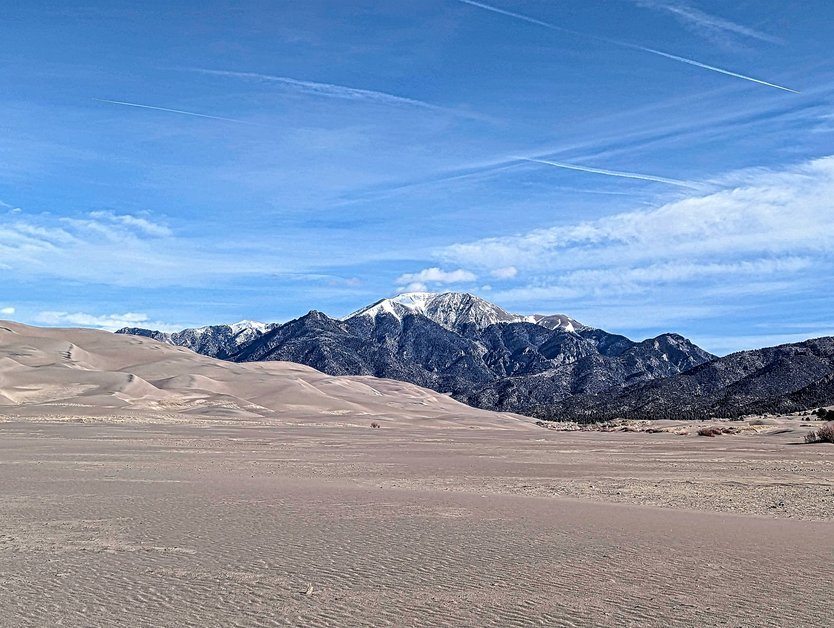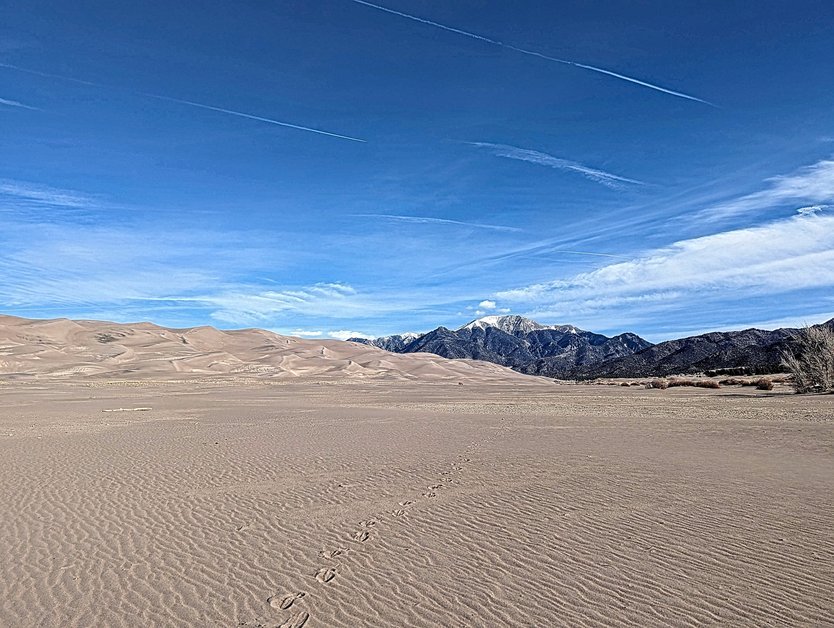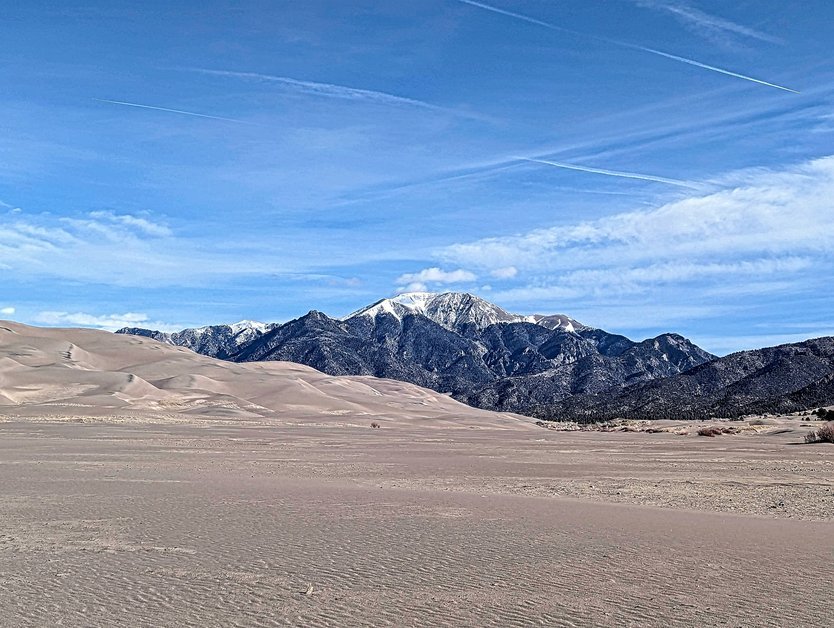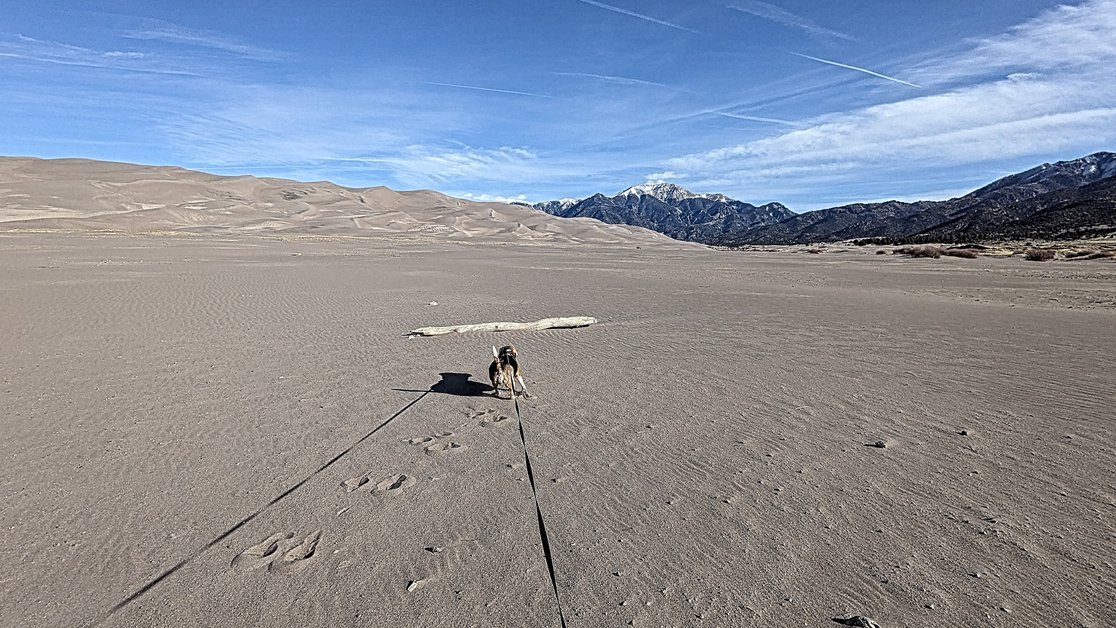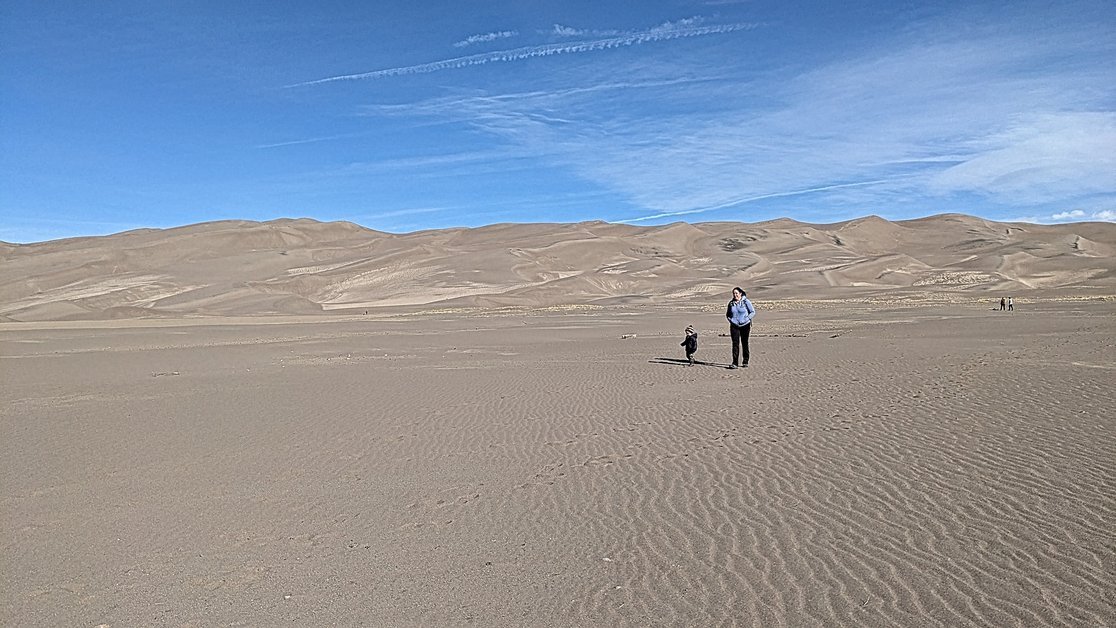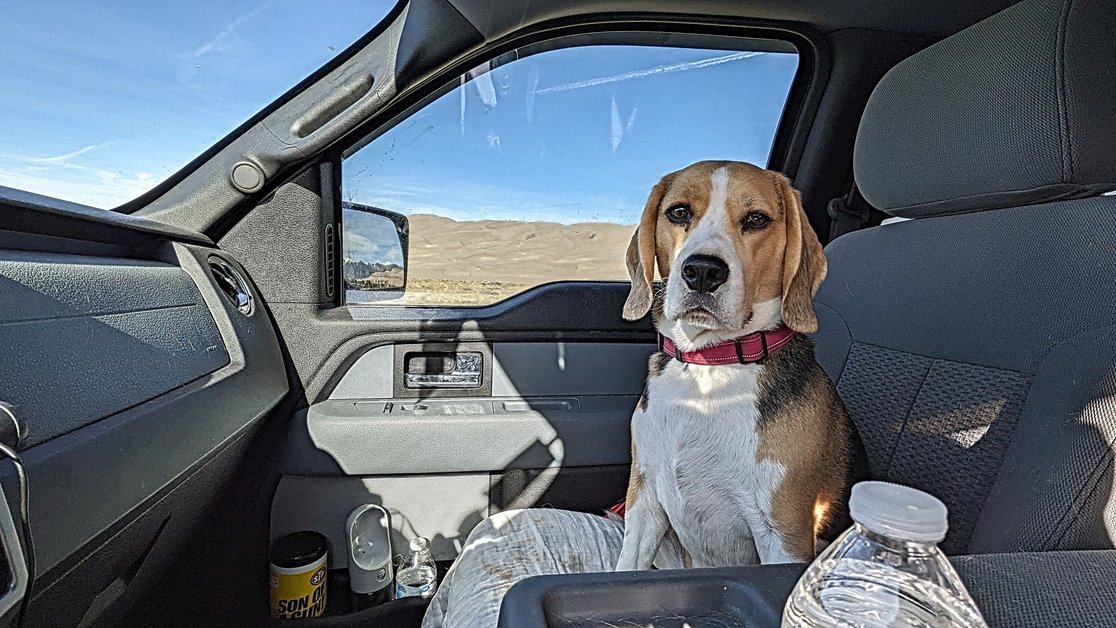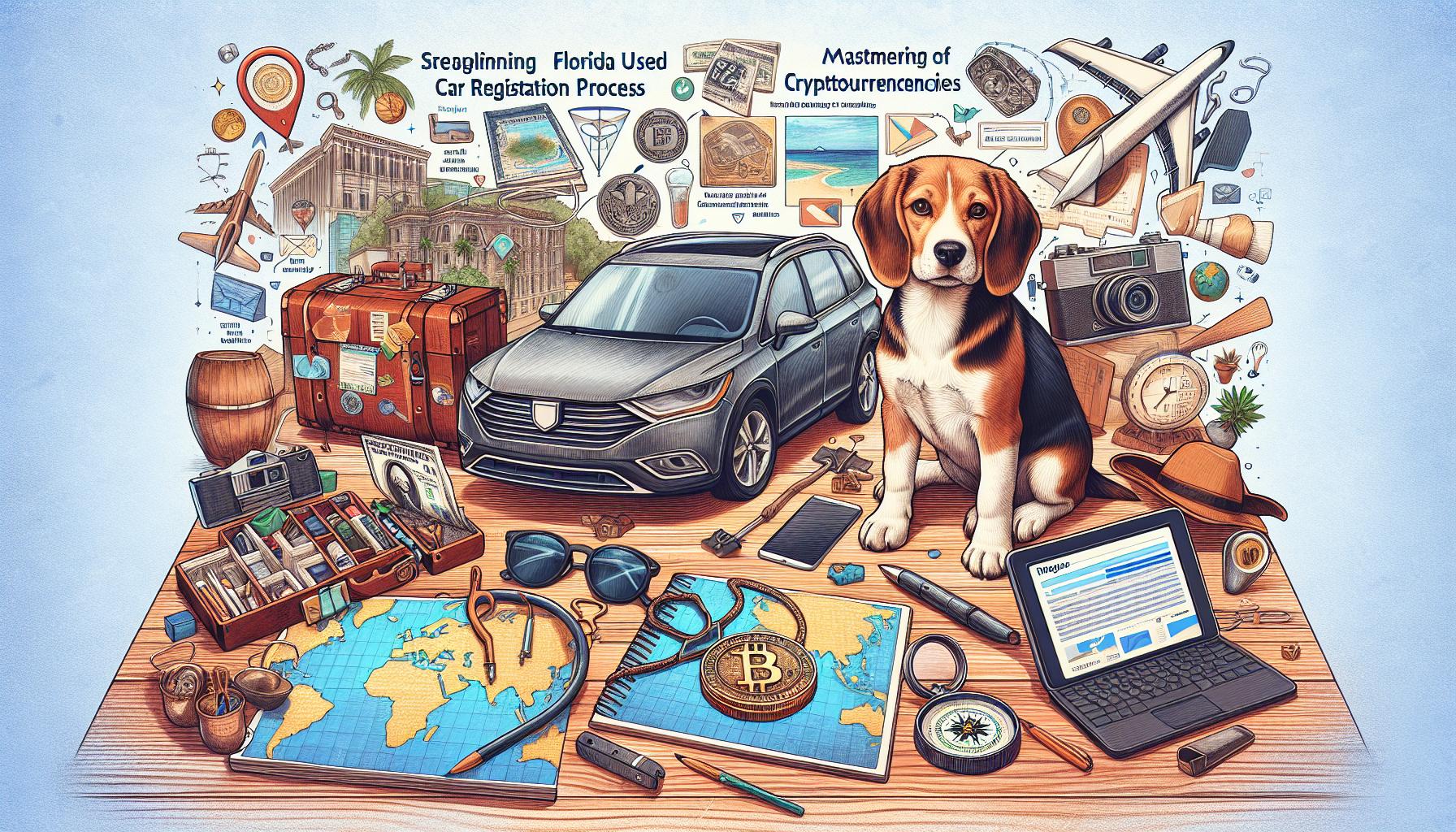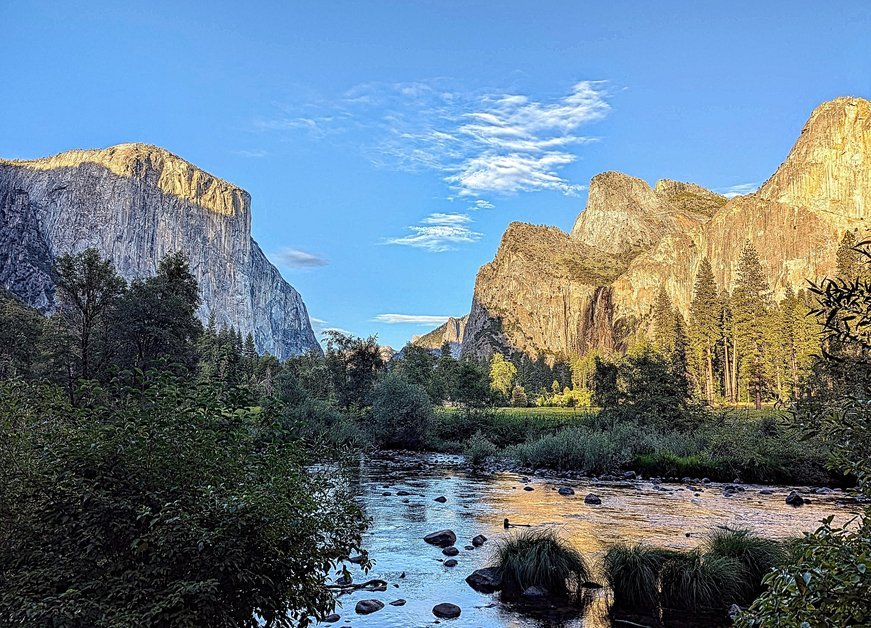Great Sand Dunes National Park sits in southern Colorado. We day tripped there in the spring of 2024 on our road-trip across America. It has enormous dunes right next to tall mountains called the Sangre de Cristo range. These dunes stand out because they are the highest in North America. Star Dune can reach about 750 feet from base to top. This huge wall of sand looks like it belongs on another planet.
Many people wonder how a place with sand this tall formed so far from any ocean. The wind shapes the sand into waves, and the view is quite different from other parks. Children often enjoy rolling down the dunes or making sandcastles at the edge of Medano Creek. In some spots, the dunes sing. This happens when sand grains rub against each other in just the right way, creating a low hum that seems to come from the ground.
It is fun to compare these dunes with other desert-like parks. For example, Exploring the Otherworldly Beauty of Badlands National Park also shows unique shapes made by wind and rain. Each place has its own look, but both can feel mysterious.
Even though this park is mostly sand, there are also forests and wetlands nearby. Snow can fall on the dunes in winter, creating patterns of white and tan. Summer brings warm days and big crowds who want to climb the dunes. The park’s location in the San Luis Valley keeps the dunes mostly sheltered from big storms. That means the shape of the dunes stays tall and sharp.
Below the dunes, Medano Creek sometimes flows like a little beach spot. People wade in the water while they rest from hiking in the hot sand. At night, the sky here is often very dark, so stargazers can see bright constellations. The park has even been recognized for its clear night skies. This makes the sand glow under moonlight, which feels magical if you see it yourself.
How So Much Sand Ended Up Here
Scientists say the dunes at Great Sand Dunes National Park started forming more than 400,000 years ago. At first, rocks in the San Juan Mountains broke down into tiny pieces. Streams and rivers carried these pieces into the San Luis Valley. Then, strong winds arrived from the southwest. They blew the sand toward the Sangre de Cristo Mountains. Because these mountains acted like a giant wall, the sand stayed in one place. This built up into the tall dunes we see today.
This ongoing process still happens each year. The wind lifts sand grains, pushes them up and over each dune ridge, and then drops them on the other side. Over time, the dunes shift, but they do not disappear. Children might think of it like building a sandcastle on the beach: the wind can knock some sand away, but new sand arrives as well.
If you like learning about how nature shapes our world, you might also enjoy reading about Pinnacles National Park: A Journey Through Time, Politics, and Preservation. That park formed from volcanic activity and earth movement. Great Sand Dunes formed mostly by wind and water, but both parks show us that Earth is always changing.
One surprising thing here is the presence of water under the sand. Medano Creek flows at the bottom of the dunes during spring and early summer, which helps move more sand downstream. Then the wind blows that sand back up. It is like a natural cycle that never stops. Some days, you can see small ripples on the dune slopes, forming patterns that look like waves on the ocean.
People who visit often notice how the dunes seem much bigger when you stand at their base. Climbing the soft sand is harder than it looks, especially on hot days. Kids might need breaks to catch their breath and drink water. Experts suggest visiting in the early morning or late afternoon, when the sand is cooler. This also makes it easier to see wildlife that come out when the sun is not too strong.
Activities for People of All Ages
Families find all sorts of fun ways to spend time here. One of the most popular things to do is sandboarding or sand sledding. Special boards can be rented in nearby towns like Alamosa or Mosca. These boards glide on the sand, almost like snowboards on a snowy hill. Children and adults can slide down gentle slopes, or braver folks can attempt steeper sections for a faster ride.
Another big draw is Medano Creek. In late spring and early summer, the creek flows at the foot of the dunes. Visitors like to walk in the shallow water, build sandcastles, or simply cool their feet. Kids often pretend this is their own sandy beach in the mountains. However, the creek can dry up by mid-summer, so check the flow before planning a water adventure.
If you love hiking, there are no marked trails on the dunes themselves, which means you can climb anywhere that looks interesting. Star Dune and High Dune are common goals. Star Dune is higher, but some choose High Dune because it can be easier to reach. Remember to protect your feet from very hot sand, especially in the middle of the day.
Visitors who want to bring their pets can look at tips in Exploring Yellowstone National Park: A Dog-Friendly Adventure. Great Sand Dunes also allows dogs in many areas, as long as they stay on leash and owners clean up after them. It’s wise to bring extra water for furry friends, because the sandy ground can get hot quickly.
At night, the park becomes an ideal spot for stargazing. The high elevation and low light pollution make it easy to see stars, constellations, and sometimes the Milky Way. Families often snuggle in blankets to watch meteors or spot satellites drifting overhead. Many say it feels peaceful to stand on sand in the dark, listening to quiet winds and gazing at the night sky.
Wildlife That Call This Place Home
Even though this park looks like a giant sandbox, it teems with life. You might spot bison grazing in the grasslands around the dunes. Elk and pronghorn wander in the distance, especially near the edges of the park. Birds, such as hawks and falcons, soar overhead looking for small rodents. These animals have adapted to the dry and windy climate.
There are also tiny creatures that live in the sand. Some are insects found nowhere else in the world. They survived here over time, becoming well-suited for the shifting dunes. The park contains more than 1,000 plant species too, including wildflowers in late spring and summer. This mix of sand, forest, and wetlands provides homes for many animals. Observing the changes in the landscape can be fun for curious kids who like to spot different plants and bugs along the way.
If you enjoy looking for mammals in wild places, you might also like Discovering the Mammals of Yellowstone National Park: A Wildlife Wonderland. Yellowstone has grizzly bears and wolves, which are not found here, but both parks are excellent spots for watching animals in their natural homes.
While exploring Great Sand Dunes, it is helpful to remember simple rules to keep wildlife safe. This includes not feeding wild animals and staying far enough away so they do not feel scared. It is also good to be calm and quiet, since loud noises might disturb them. In some areas of the park, rangers request that visitors stay on marked roads or paths to protect delicate habitats.
A few lucky visitors might see nocturnal animals like foxes or owls once the sun goes down. Others might hear small creatures rustling in the sand at dusk. Patience is key, especially if you want to take pictures. Always keep your camera ready, but avoid getting too close. Remember, wildlife should stay wild, and that starts by giving them enough space to roam.
Best Seasons and Travel Tips
Great Sand Dunes National Park offers different joys in each season. Spring can be cool with daytime temperatures around 50–70°F. This is when Medano Creek might start flowing, letting you walk in cold water. Expect cooler nights, so a jacket helps if you camp. In summer, the sand gets very hot—sometimes over 150°F—so it’s wise to wear shoes on the dunes. Mornings and evenings can be more pleasant for exploring.
Fall brings cooler days again and fewer visitors. The changing leaves in the nearby mountains look pretty against the sandy slopes. Winter can be peaceful, with occasional snow that forms white streaks on the dunes. Sometimes the dunes freeze on top, which can make climbing easier. But be aware of cold nights and possible storms in the mountains.
For any season, pack these basics:
- Water: The dry air can dehydrate you faster than expected.
- Sun Protection: Sunglasses, hats, and sunscreen help shield you from strong rays.
- Shoes or Sandals: The sand can get hot or cold, so bare feet might not feel good.
Driving to the park is straightforward via US Highway 160 and State Highway 150. If you visit in spring, check conditions on mountain passes. Some roads around Colorado can still have snow. You can learn more tips on spring travel in Navigating US National Parks Road Closures in Spring.
Flying is also possible if you land in San Luis Valley Regional Airport near Alamosa, about 40 minutes away. Larger airports in Colorado Springs or Denver are a bit farther but might have more flight options. No matter how you get here, arrive with enough time to explore. Some families like to spend one full day on the dunes, another day relaxing in the creek (if it’s flowing), and a night stargazing.
If you come in peak summer months, aim for early morning or late afternoon hikes. Midday sand can be scorching, and strong sun can tire people quickly. Always keep extra water in your car. Some folks underestimate how dry the air is, which can lead to dehydration faster than in humid places.
Setting Up Camp: Where to Stay
Camping in or near Great Sand Dunes National Park can be a fun experience for families who like sleeping outdoors. The main campground inside the park is called Piñon Flats Campground. It has 88 campsites, drinking water, and restrooms. From this campground, you can walk straight to the dunes. In peak seasons, campsites can fill up quickly, so making a reservation is a good idea.
Some people prefer more remote camping. A four-wheel-drive road called Medano Pass Primitive Road allows backcountry camping in certain spots. This is more rugged. You drive on a sandy and rocky route, and you should check the road conditions in advance because the stream crossings can be high. Backcountry camping means there are no bathrooms or running water, so you must bring all your supplies and pack out all trash.
If you have an RV or want full hookups, consider looking in nearby towns like Alamosa, Mosca, or Blanca. These places have private campgrounds with electric, water, and sometimes showers. To compare experiences between park campgrounds and more developed RV sites, look at The Reality of RV National Park Campgrounds: Expectations vs. Reality. Some people enjoy the simpler nature of park campgrounds, while others want the comfort of showers and electricity.
Here are some general tips for campers:
- Check Fire Rules: Sometimes there are fire bans due to dry weather.
- Store Food Safely: Wildlife might visit campsites looking for snacks. Keep food in secure containers or your vehicle.
- Pack Extra Warm Clothing: Nights in the high desert can get cold, even in summer.
Staying overnight allows you to see the dunes at dawn or watch the sun set over the mountains. The colors can be breathtaking. If you are lucky, you might witness the sky turn bright orange or pink, reflecting on the sand. Early mornings and late evenings are also great times to spot wildlife. Many animals come out when it is cooler, so you have a better chance of seeing them up close.
Interesting Facts You Should Know
There are many fun facts about this place that can make your visit even more exciting. First, Star Dune is one of the highest dunes in North America, towering around 750 feet above the valley floor. Climbing it requires plenty of energy, but the view from the top lets you see miles of rolling sand. You can also witness the “slip face,” where sand tumbles down the steep slope like a slow waterfall.
Another interesting feature is called singing sand. On certain days, when the sand is very dry and you move downhill, you might hear a gentle humming sound. Scientists think this happens because sand grains rub together just right, producing a slow, deep note that travels through the dunes. It may feel a bit magical if you have never heard it before.
At night, this area becomes a Dark Sky Park, meaning it has very little light pollution. This makes the stars shine bright, and on clear evenings, you might see shooting stars or the Milky Way. Exploring Glacier National Park in Early May: A Guide to Spring Adventures can also show you a place known for starry skies and scenic views, though the landscapes are quite different.
Even though the dunes are the main attraction, the park also protects other habitats. You might find alpine lakes, wetlands, and even forests in certain areas. This variety allows more than 1,000 plant species, 250 bird species, and 90 kinds of mammals to live here. Some insect species are only found in these dunes. Researchers continue to discover new facts about how these living things survive in such shifting land.
The dunes are thought to be over 400,000 years old. Over centuries, the shapes have changed slightly, but the main dune field stayed in the same region because of the mountains blocking the winds. Every visit might look a bit different, though, because the wind rearranges the sand daily. On a breezy day, you might notice ripples forming faster than you can walk. It is a living landscape that changes hour by hour.
Helping Protect the Park
Like all national parks, Great Sand Dunes needs careful attention from visitors to stay healthy and clean. One way to help is by packing out all your trash, whether that is water bottles, food wrappers, or other items. The strong winds can blow garbage all over the dunes. Keeping the park free of litter helps the wildlife and keeps the sand looking pretty.
If you plan to bring a dog, know the rules about where dogs can go. The dunes allow pets in many areas, but they must be on a leash. Owners should also pick up any pet waste so it does not harm the environment. For more tips on traveling with a dog, you can see Taking Dogs to Grand Canyon National Park. Although these two parks are different, many basic pet rules remain the same across national parks.
Another helpful practice is to avoid stepping on delicate plants. Some flowers and shrubs grow along the edges of the dunes, and their roots help keep the sand in place. If people trample them, the sand can move in ways that harm the habitat. Children can learn early on that staying on sturdy ground or open sand is better for protecting the park.
If you see wildlife, it is best to observe from a distance. Large animals like elk or bison can become defensive if they feel threatened. Small creatures also need space to feed and move around. Never feed wild animals, even if they look cute or hungry. Human food does not help them, and it can make them lose their natural instincts.
Finally, be respectful of the land’s history. These dunes hold cultural importance for many Native American tribes who lived in the region. Exploring the park with care and curiosity helps keep its natural beauty alive for the future. A little effort from each visitor—like using existing roads, following speed limits, and leaving no trace—goes a long way.
Frequently Asked Questions
Q: Can I bring my dog to Great Sand Dunes National Park?
A: Yes. Dogs are allowed in most areas if they remain on a leash. Bring extra water for them, and be careful on hot sand.
Q: Is there a Junior Ranger program at Great Sand Dunes National Park?
A: Yes. We got the badge after completing the workbook.
Q: Is there a BARK Ranger program Great Sand Dunes National Park?
A: No.
Q: Do I need a special permit to camp there?
A: You do not need a special permit for Piñon Flats Campground if you reserve a spot. For backcountry camping, you usually need a free permit from the park office.
Q: When is Medano Creek flowing?
A: It typically flows from late spring to early summer, depending on snowmelt. By mid-summer, the water level drops and may dry up.
Q: How hot can the sand get?
A: The surface can reach over 150°F in summer afternoons, so wearing closed-toe shoes is helpful to avoid burns.
Q: Is there a best time of day to climb the dunes?
A: Early morning or late afternoon is cooler, and the sunlight can also create beautiful shadows on the dunes.
Q: What are some fun things for kids to do?
A: Children enjoy sandboarding, looking for animal tracks, splashing in Medano Creek, and watching for wildlife.
Q: Do I need a four-wheel drive car to see the park?
A: You can reach the main dunes area with a standard vehicle. Four-wheel drive is only needed if you plan to explore the Medano Pass Primitive Road for backcountry camping.
Q: Are there any grocery stores close by?
A: Towns like Alamosa have grocery stores, gas stations, and places to eat. They are about 30–45 minutes from the park.
Enjoy your visit to Great Sand Dunes National Park and remember these simple tips for a fun and safe adventure.


